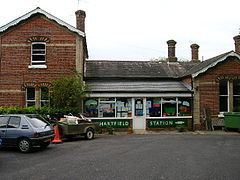Grid reference TQ480362 Platforms in use 1 | 1 October 1866 Opened | |
 | ||
Post-grouping Southern RailwaySouthern Region of British Railways Similar Withyham railway station, Forest Row railway station, Mountfield Halt railway st, Bishopstone Beach Halt railway st, Heathfield (Sussex) railway st | ||
Hartfield was a railway station serving Hartfield, England, on the Three Bridges to Tunbridge Wells Central Line which closed in 1967, a casualty of the Beeching Axe.
The station opened on 1 October 1866 and the buildings were designed by Charles Henry Driver.
The station building is now divided between a day nursery and a private house. The route of the railway line is now a cycle path (the Forest Way). A.A. Milne, the creator of Winnie-the-Pooh, lived in Hartfield.
The station appears in a delightful British Transport Film entitled Farmer Moving South, which recounted the moving of the entire farm stock of Sir Robert Ropner by special train from Skutterskelfe Hall in Yorkshire to Hartfield in December 1950. The entire move took 30 hours and was nine hours late in arriving at East Grinstead on 15 December. The film is available on a BFI DVD.
Reopening
With regard to the possible reopening of the remaining section of the line from Tunbridge Wells to Three Bridges, number of obstacles would appear to stand in the way of such action, most notably:
1) An industrial site currently occupies the former location of Forest Row railway station as well as a small recycling centre to west.
2) The formation has been built across in several places notably in East Grinstead where about one mile of the trackbed from Station Road to the Lewes Road tunnel has been taken over for a relief road (the A22 ironically named "Beechings Way" after Richard Beeching whose recommendations closed the railway line). As there is no feasible alternative route into the station, this road would need to be reconverted back to rail. Any such action would in all likelihood result in a cut in capacity on an already highly congested road network.
3) The site of Grange Road has disappeared under a small parade of shops as well as housing which block 0.64 miles of the formation.
